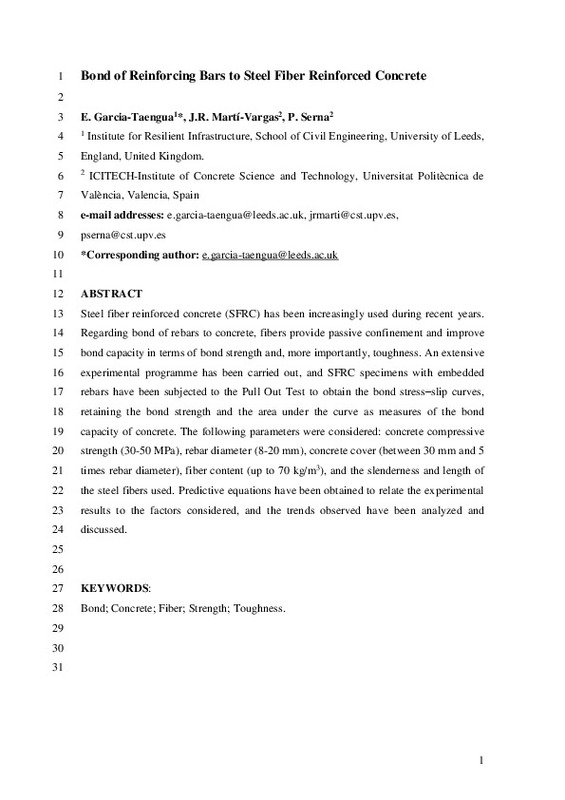JavaScript is disabled for your browser. Some features of this site may not work without it.
Buscar en RiuNet
Listar
Mi cuenta
Estadísticas
Ayuda RiuNet
Admin. UPV
Bond of reinforcing bars to steel fiber reinforced concrete
Mostrar el registro sencillo del ítem
Ficheros en el ítem
| dc.contributor.author | García Taengua, Emilio José
|
es_ES |
| dc.contributor.author | Martí Vargas, José Rocío
|
es_ES |
| dc.contributor.author | Serna Ros, Pedro
|
es_ES |
| dc.date.accessioned | 2017-07-19T18:08:06Z | |
| dc.date.available | 2017-07-19T18:08:06Z | |
| dc.date.issued | 2016-02 | |
| dc.identifier.issn | 0950-0618 | |
| dc.identifier.uri | http://hdl.handle.net/10251/85469 | |
| dc.description.abstract | Steel fiber reinforced concrete (SFRC) has been increasingly used during recent years. Regarding bond of rebars to concrete, fibers provide passive confinement and improve bond capacity in terms of bond strength and, more importantly, toughness. An extensive experimental programme has been carried out, and SFRC specimens with embedded rebars have been subjected to the Pull Out Test to obtain the bond stress slip curves, retaining the bond strength and the area under the curve as measures of the bond capacity of concrete. The following parameters were considered: concrete compressive strength (30-50 MPa), rebar diameter (8-20 mm), concrete cover (between 30 mm and 5 times rebar diameter), fiber content (up to 70 kg/m(3)), and the slenderness and length of the steel fibers used. Predictive equations have been obtained to relate the experimental results to the factors considered, and the trends observed have been analyzed and discussed. (C) 2015 Elsevier Ltd. All rights reserved. | es_ES |
| dc.description.sponsorship | The authors of this work wish to thank both the Research Bureau of the Spanish Ministry of Science and Innovation for the funding of the projects 'BIA 2009-12722' and 'BIA 2012-35776-AR', this research being a part thereof. | en_EN |
| dc.language | Inglés | es_ES |
| dc.publisher | Elsevier | es_ES |
| dc.relation.ispartof | Construction and Building Materials | es_ES |
| dc.rights | Reconocimiento - No comercial - Sin obra derivada (by-nc-nd) | es_ES |
| dc.subject | Bond | es_ES |
| dc.subject | Concrete | es_ES |
| dc.subject | Fiber | es_ES |
| dc.subject | Strength | es_ES |
| dc.subject | Toughness | es_ES |
| dc.subject.classification | INGENIERIA DE LA CONSTRUCCION | es_ES |
| dc.title | Bond of reinforcing bars to steel fiber reinforced concrete | es_ES |
| dc.type | Artículo | es_ES |
| dc.identifier.doi | 10.1016/j.conbuildmat.2015.12.044 | |
| dc.relation.projectID | info:eu-repo/grantAgreement/MICINN//BIA2009-12722/ES/EL HORMIGON DE FIBRAS DE ACERO COMO SUPERACION DEL HORMIGON TRADICIONAL Y SUS PERSPECTIVAS DE FUTURO/ | es_ES |
| dc.relation.projectID | info:eu-repo/grantAgreement/MINECO//BIA2012-35776/ES/HORMIGON DE FIBRAS: UNA SOLUCION PARA CADA NECESIDAD/ | es_ES |
| dc.rights.accessRights | Abierto | es_ES |
| dc.contributor.affiliation | Universitat Politècnica de València. Escuela Técnica Superior de Ingenieros de Caminos, Canales y Puertos - Escola Tècnica Superior d'Enginyers de Camins, Canals i Ports | es_ES |
| dc.contributor.affiliation | Universitat Politècnica de València. Departamento de Ingeniería de la Construcción y de Proyectos de Ingeniería Civil - Departament d'Enginyeria de la Construcció i de Projectes d'Enginyeria Civil | es_ES |
| dc.description.bibliographicCitation | García Taengua, EJ.; Martí Vargas, JR.; Serna Ros, P. (2016). Bond of reinforcing bars to steel fiber reinforced concrete. Construction and Building Materials. 105:275-284. https://doi.org/10.1016/j.conbuildmat.2015.12.044 | es_ES |
| dc.description.accrualMethod | S | es_ES |
| dc.relation.publisherversion | https://doi.org/10.1016/j.conbuildmat.2015.12.044 | es_ES |
| dc.description.upvformatpinicio | 275 | es_ES |
| dc.description.upvformatpfin | 284 | es_ES |
| dc.type.version | info:eu-repo/semantics/publishedVersion | es_ES |
| dc.description.volume | 105 | es_ES |
| dc.relation.senia | 326125 | es_ES |
| dc.contributor.funder | Ministerio de Ciencia e Innovación | es_ES |
| dc.contributor.funder | Ministerio de Economía y Competitividad | es_ES |






![[Cerrado]](/themes/UPV/images/candado.png)


